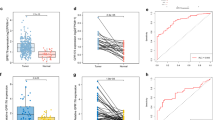Abstract
G protein-coupled receptor, family C, group 5, member A (GPRC5A) had received attentions for its role in carcinogenesis and prognostic values in several types of cancer. However, the functional roles of GPRC5A in gastric cancer (GC) had never been elucidated. The expression levels of GPRC5A were detected by real-time quantitative reverse transcription PCR and Western blot in GC tissues and adjacent non-tumor tissues. GPRC5A expression in tissue sections of 106 GC samples was evaluated using immunohistochemistry. The staining results were compared with clinicopathological factors and to the prognosis of GC patients. The mRNA and protein expression levels of GPRC5A in gastric cancer tissues were higher than those in adjacent non-tumor tissues. Positive GPRC5A expression was significantly correlated with larger size of primary tumor, diffuse type (Lauren’s classification), deeper serosal invasion, and more lymph node metastasis. In addition, Kaplan–Meier curve analysis demonstrated that GC patients with positive GPRC5A expression had poor prognosis than those with negative GPRC5A expression. GPRC5A expression was identified as an independent factor of the overall survival in GC patients by multivariate Cox analysis. Further, the overall survival difference existed between patients with GPRC5A positive and negative groups in GC patients with lymph node metastasis. Our results suggested that elevated levels of GPRC5A played significant roles in GC progression. GPRC5A could serve as a prognostic biomarker of GC.





Similar content being viewed by others
References
Siegel R, Naishadham D, Jemal A. Cancer statistics, 2013. CA Cancer J Clin. 2013;63(1):11–30.
Verlato G, Marrelli D, Accordini S, Bencivenga M, Di Leo A, Marchet A, et al. Short-term and long-term risk factors in gastric cancer. World J Gastroenterol. 2015;21(21):6434–43.
Shen L, Shan YS, Hu HM, Price TJ, Sirohi B, Yeh KH, et al. Management of gastric cancer in Asia: resource-stratified guidelines. Lancet Oncol. 2013;14(12):535–47.
Otani K, Li X, Arakawa T, Chan FK, Yu J. Epigenetic-mediated tumor suppressor genes as diagnostic or prognostic biomarkers in gastric cancer. Expert Rev Mol Diagn. 2013;13(5):445–55.
Cheng Y, Lotan R. Molecular cloning and characterization of a novel retinoic acid-inducible gene that encodes a putative G protein-coupled receptor. J Biol Chem. 1998;273(52):35008–15.
Tao Q, Fujimoto J, Men T, Ye X, Deng J, Lacroix L, et al. Identification of the retinoic acid-inducible Gprc5a as a new lung tumor suppressor gene. J Natl Cancer Inst. 2007;99(22):1668–82.
Barta P, Van Pelt C, Men T, Dickey BF, Lotan R, Moghaddam SJ. Enhancement of lung tumorigenesis in a Gprc5a knockout mouse by chronic extrinsic airway inflammation. Mol Cancer. 2012;11:4. doi:10.1186/1476-4598-11-4.
Sokolenko AP, Bulanova DR, Iyevleva AG, Aleksakhina SN, Preobrazhenskaya EV, Ivantsov AO, et al. High prevalence of GPRC5A germline mutations in BRCA1-mutant breast cancer patients. Int J Cancer. 2014;134(10):2352–8.
Zougman A, Hutchins GG, Cairns DA, Verghese E, Perry SL, Jayne DG, et al. Retinoic acid-induced protein 3: identification and characterisation of a novel prognostic colon cancer biomarker. Eur J Cancer. 2013;49(2):531–9.
Liu SL, Zhong SS, Ye DX, Chen WT, Zhang ZY, Deng J. Repression of G protein-coupled receptor family C group 5 member A is associated with pathologic differentiation grade of oral squamous cell carcinoma. J Oral Pathol Med. 2013;42(10):761–8.
Dairkee SH, Sayeed A, Luciani G, Champion S, Meng Z, Jakkula LR, et al. Immutable functional attributes of histologic grade revealed by context-independent gene expression in primary breast cancer cells. Cancer Res. 2009;69(19):7826–34.
Acquafreda T, Soprano KJ, Soprano DR. GPRC5A: a potential tumor suppressor and oncogene. Cancer Biol Ther. 2009;8(10):963–5.
Zheng J, Guo X, Gao X, Liu H, Tu Y, Zhang Y. Overexpression of retinoic acid-induced protein 3 predicts poor prognosis for hepatocellular carcinoma. Clin Transl Oncol. 2014;16(1):57–63.
Xin H, Wang K, Hu G, Xie F, Ouyang K, Tang X, et al. Establishment and characterization of 7 novel hepatocellular carcinoma cell lines from patient-derived tumor xenografts. PLoS One. 2014;9(1), e85308.
Wu Q, Ding W, Mirza A, Van Arsdale T, Wei I, Bishop WR, et al. Integrative genomics revealed RAI3 is a cell growth-promoting gene and a novel P53 transcriptional target. J Biol Chem. 2005;280(13):12935–43.
Cheng L, Yang S, Yang Y, Zhang W, Xiao H, Gao H, et al. Global gene expression and functional network analysis of gastric cancer identify extended pathway maps and GPRC5A as a potential biomarker. Cancer Lett. 2012;326(1):105–13.
Jörissen H, Bektas N, Dahl E, Hartmann A, ten Haaf A, Di Fiore S, et al. Production and characterisation of monoclonal antibodies against RAI3 and its expression in human breast cancer. BMC Cancer. 2009;9:200.
Deng J, Fujimoto J, Ye XF, Men TY, Van Pelt CS, Chen YL, et al. Knockout of the tumor suppressor gene Gprc5a in mice leads to NF-kappaB activation in airway epithelium and promotes lung inflammation and tumorigenesis. Cancer Prev Res (Phila). 2010;3(4):424–37.
Chen Y, Deng J, Fujimoto J, Kadara H, Men T, Lotan D, et al. Gprc5a deletion enhances the transformed phenotype in normal and malignant lung epithelial cells by eliciting persistent Stat3 signaling induced by autocrine leukemia inhibitory factor. Cancer Res. 2010;70(21):8917–26.
Zhou H, Rigoutsos I. The emerging roles of GPRC5A in diseases. Oncoscience. 2014;1(12):765–76.
Zhong S, Yin H, Liao Y, Yao F, Li Q, Zhang J, et al. Lung tumor suppressor GPRC5A binds EGFR and restrains its effector signaling. Cancer Res. 2015;75(9):1801–14.
Fujimoto J, Kadara H, Men T, van Pelt C, Lotan D, Lotan R. Comparative functional genomics analysis of NNK tobacco-carcinogen induced lung adenocarcinoma development in Gprc5a-knockout mice. PLoS One. 2010;5(7), e11847.
Acknowledgments
This work was supported by the National Natural Science Foundation of China (No. 81403220 and No. 81303095)
Conflicts of interest
None
Author information
Authors and Affiliations
Corresponding author
Additional information
Yunchao Zhang is the joint first author.
Rights and permissions
About this article
Cite this article
Liu, H., Zhang, Y., Hao, X. et al. GPRC5A overexpression predicted advanced biological behaviors and poor prognosis in patients with gastric cancer. Tumor Biol. 37, 503–510 (2016). https://doi.org/10.1007/s13277-015-3817-0
Received:
Accepted:
Published:
Issue Date:
DOI: https://doi.org/10.1007/s13277-015-3817-0




